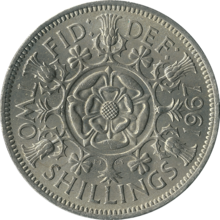British coin Florin
| United Kingdom | |
| Value | 1⁄10 pound sterling |
|---|---|
| Mass | 11.31 g |
| Diameter | (1849-1850) 28.0 mm (1851-1886) 30.0 mm (1887-1892) 29.5 mm (1893-1970) 28.5 mm |
| Edge | Milled |
| Composition | (1849-1919) 92.5% Ag (1920-1946) 50% Ag (1947-1970) Cupronickel |
| Years of minting | 1849-1970 |
| Obverse | |
 |
|
| Design | Profile of the monarch (Elizabeth II design shown) |
| Designer | Mary Gillick |
| Design date | 1953 |
| Reverse | |
 |
|
| Design | Various (floral design shown) |
| Designer | Edgar Fuller and Cecil Thomas |
| Design date | 1953 |
The British two shilling coin, also known as the florin or "two bob bit", was issued from 1849 until 1967. It was worth one tenth of a pound, or twenty-four old pence. It should not be confused with the medieval gold florin, which was nominally worth six shillings.
In 1968, in the run-up to decimalisation, the two shilling coin was superseded by the decimal ten pence coin, which had the same value and initially the same size and weight. It continued in circulation, alongside the ten pence coin, until 1993, when the 10p was reduced in size.
In 1847 a motion was introduced in Parliament calling for the introduction of a decimal currency and the striking of coins of one-tenth and one-hundredth of a pound. The motion was subsequently withdrawn on the understanding that a one-tenth pound coin would be produced to test public opinion. There was considerable discussion about what the coin should be called, with centum, decade, and dime being among the suggestions, before florin was eventually settled upon, partly because of its connection with old English coinage, and partly because other European countries also had coins of approximately the same size and weight called florins.
The first florins were struck in 1849 as silver coins weighing 11.3 grams and having a diameter of 28 millimetres. These first coins would have come as rather a shock to the public, as for the first time in nearly 200 years a British coin featured a portrait of the monarch wearing a crown. Even more of a shock, including (allegedly) to Queen Victoria herself, was the omission of D G – Dei Gratia ("by the grace of God") – from the coin's inscription, which resulted in it being popularly known as the godless florin. The inscription around the obverse read VICTORIA REGINA 1849. The reverse featured four crowned cruciform shields with a rose in the centre, with the shields separated by a rose, thistle, rose, and a shamrock; the inscription on the reverse was ONE FLORIN ONE TENTH OF A POUND. The "godless florin" may have also been minted in 1850 and 1851 with the date 1849.
...
Wikipedia
